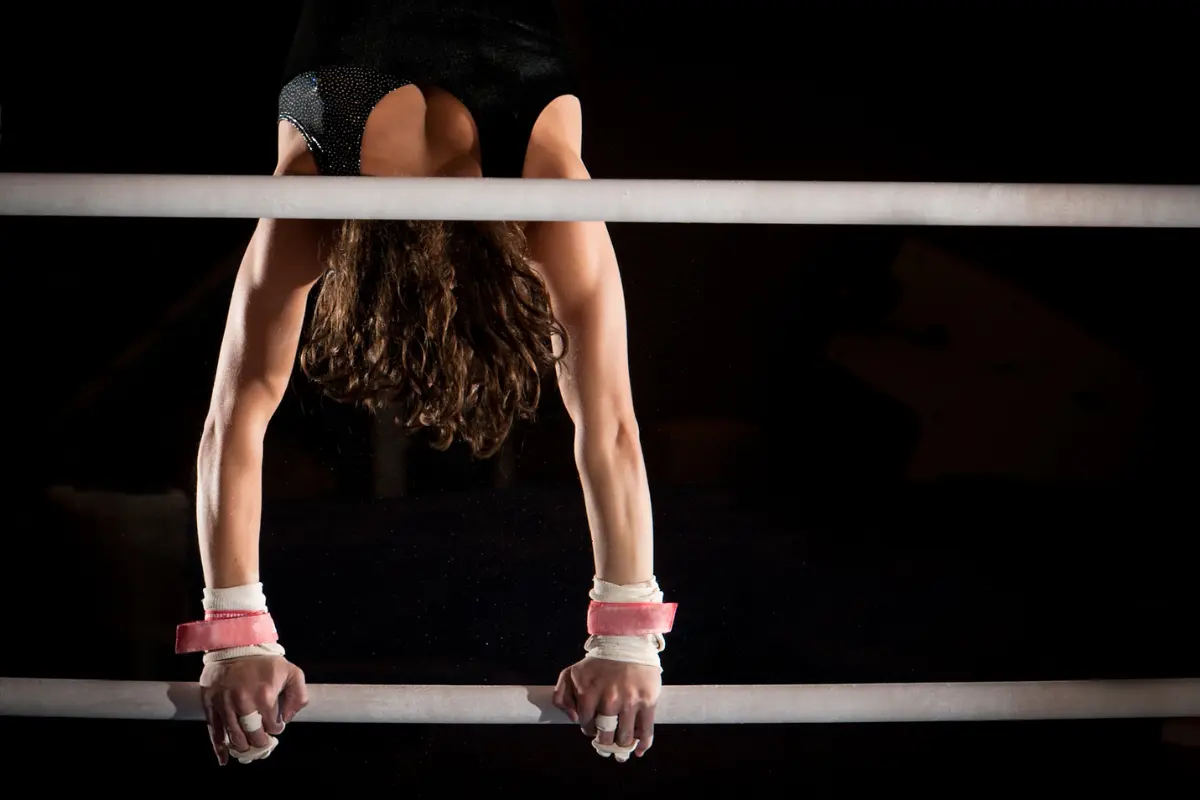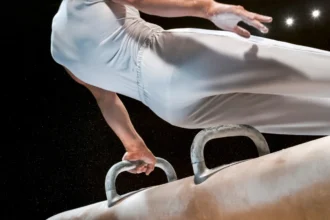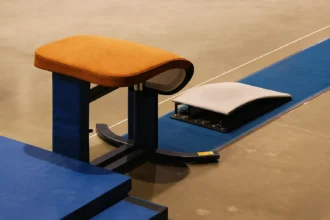In women’s artistic gymnastics, the uneven bars are the second event in the Olympic lineup. This apparatus is made of fiberglass with a wood coating, and the bars are set at different heights, letting the gymnast transition between them smoothly.
We’ll take a look at the 7 most difficult uneven bars skills, as detailed in the 2022-24 Code of Points, highlighting the technical skill needed to pull them off:
1. The Ray (Double Twisting Double Layout Dismount)
- Code Value: G
- Type: Dismount
- First Performed By: Elise Ray (USA), 2000 Sydney Olympics
The Ray III is a spectacular dismount that combines two full twisting rotations with two layout backflips. The gymnast swings into a stretched double salto backward, fitting in two full twists before landing.
Key technical demands:
- Two back flips in a stretched layout body position (slower than tuck).
- Two full twists (720°), usually one per flip.
- Requires massive swing power to gain height and airtime.
Because the body is fully extended, both flipping and twisting compete for precious time in the air. This makes the Ray one of the riskiest high-value dismounts.
Judges deduct harshly if twists are incomplete or legs break position. Many gymnasts prefer safer options like a double layout (F) or full-twisting double tuck (E) to maximize consistency.
2. Full-Twisting Gienger (Def Release Move)
- Code Value: G
- Type: Release
- Origins: From the Gienger family, refined in men’s gymnastics as the “Def.”
The Full-Twisting Gienger is a twisting release where the gymnast performs a layout backflip with 1½ twists before regrasping the same bar.
Key technical demands:
- Layout back salto with full body extension.
- One and a half twists (540° total).
- A blind catch on the same bar after flipping.
This skill is high-risk because the gymnast must rotate and twist without seeing the bar until the very last moment. On top of that, the layout position makes the release less forgiving.
While once more common, today’s gymnasts avoid it due to high danger, difficulty connecting into combos, and the real risk of striking the bar mid-skill. Safer, more linkable releases (like the Pak or Church) dominate modern routines.
3. Round-Off Arabian Mount
- Code Value: G
- Type: Mount
- First Known Performers: Olesya Dudnik & Michelle Goodwin, 1980s
One of the flashiest ways to start a routine, the Round-Off Arabian Mount launches the gymnast onto the high bar using tumbling momentum. The mount begins with a round-off onto the springboard, immediately into a piked Arabian salto (a front flip with a half twist) over the low bar to catch the high bar.
Key technical demands:
- Round-off generates backward drive.
- Arabian salto redirects forward motion into backward mid-air.
- Gymnast must clear the low bar cleanly while catching the high bar.
It is the only G-rated mount in the Code of Points. Yet, it’s nearly extinct, too risky for too little reward. Missing it means starting the routine with a fall, and because mounts can’t earn connection bonuses, the danger outweighs the value. Today, gymnasts stick to safe entries like glide kips or jumps to high bar.
4. The Mo Salto
- Code Value: G
- Type: Release
- First Performed By: Mo Huilan (CHN), mid-1990s
The Mo Salto is one of the rare forward-release elements in elite gymnastics. The gymnast swings forward, lets go of the bar, performs a tucked front salto over the high bar, and regrabs it on the opposite side.
Key technical demands:
- Forward momentum release (opposite of most bar skills).
- Tucked front flip directly over the high bar.
- Precise regrasp timing with minimal visibility.
Though innovative, it has largely disappeared from international competition. By the 2000s, even Chinese gymnasts, who pioneered the move stopped performing it consistently. The forward direction makes it uniquely risky and difficult to connect into other skills.
5. The Black
- Code Value: G
- Type: Release
- First Performed By: Ellie Black (CAN), 2022 Paris World Challenge Cup
One of the newest entries to the Code, The Black is a creative release involving a clear hip circle entry into a counter pike salto, with a ½ twist and a catch in mixed L grip.
Key technical demands:
- Unusual entry from a clear hip circle (instead of toe-on or tap).
- Counter pike release with legs straight.
- Early half twist in flight.
- Catch in mixed L grip (one hand over, one under).
This combination of non-traditional entry, mid-air twist, and grip change makes The Black deceptively hard. It reflects a new generation of bar work where originality, grip changes, and twisting elements are raising the ceiling of difficulty.
6. Triple Back Dismount (The Magaña)
- Code Value: G
- Type: Dismount
- First Performed By: Brenda Magaña (MEX), 2002 World Championships
The Triple Back Dismount is one of the most extreme bar skills ever landed. From a giant swing, the gymnast releases the bar and performs three consecutive backflips in tuck before attempting a clean landing.
Key technical demands:
- Tap swing into enormous lift.
- Three full rotations in tuck.
- Controlled landing without under- or over-rotation.
Brenda Magaña made history in 2002 as the first woman to land it in competition. Since then, no other gymnast has repeated it at the elite level, showing just how dangerous and demanding it is. Even men on high bar rarely attempt triple tucks.
7. The Derwael II
- Code Value: G (originally H in 2021)
- Type: Release
- First Performed By: Nina Derwael (BEL), 2021 European Championships
The Derwael II is a modern masterpiece that combines toe-on entry, layout counter-flight, a half twist, and a catch in mixed grip. Nina Derwael, Olympic champion and bars specialist, unveiled it in 2021, where it was originally given an H-value, the highest at the time.
Key technical demands:
- Toe-on sole circle (Shaposh entry).
- Layout counter-flight (similar to a Hindorff, but stretched).
- Half twist mid-air before regrasp.
- Catch in mixed grip.
Derwael remains the only gymnast to successfully perform this release in competition. Its complexity makes it one of the most elegant and technically stunning elements in gymnastics today.
| Skill Name | Code Value | Element Type | First Performer |
|---|---|---|---|
| The Ray (Double Twisting Double Layout Dismount) | G | Dismount | Elise Ray (USA), 2000 Olympics |
| Full-Twisting Gienger (Def) | G | Release | Linked to Tamás Dévay (HUN) |
| Round-Off Arabian Mount | G | Mount | Olesya Dudnik / Michelle Goodwin (1980s) |
| The Mo Salto | G | Release | Mo Huilan (CHN), mid-1990s |
| The Black | G | Release | Ellie Black (CAN), 2022 |
| Triple Back Dismount (The Magaña) | G | Dismount | Brenda Magaña (MEX), 2002 Worlds |
| The Derwael II | G | Release | Nina Derwael (BEL), 2021 Euros |













